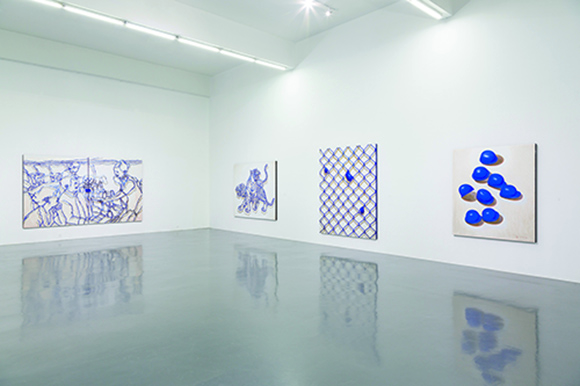ZHANG HUI: PLAZA
| June 24, 2014 | Post In LEAP 27

From left: Blueprint.Communication I, Blueprint.Communication II, Blueprint.Expansion, Blueprint.Assemble
Courtesy of Long March Space
The paintings of Zhang Hui offer neither fulfilling content nor aestheticism, and despite depicting concrete objects and scenes with clear brushstrokes, do not make reference to the real world in any clear way. Instead, his paintings move unhurriedly towards the image as the outcome of the duty stipulated by the act of painting, and stop at the point between the expression of experience and the becoming of the image, as layers of brushworks manifest the distinctive chaos and synchronicity of painting as described by Paul Cézanne, to pense en peinture. In reality, when painting simultaneously serves as the result of a set of actions and as a state of reflection, it ensures that the gaze of the viewer is not bound to the content of the image, thereby moving to a non-visual logic which lies outside of the latter’s control, but, by indulging in the attraction of the image’s appearance, will also not rapidly veer outside of the painting itself. In other words, Zhang’s paintings cautiously traverse the narrow space between the wonder of the image and the thrill of formal technique; the particular charm of his works is produced by an evasion of both these boundaries, and the nervous tension that arises between.
Compared to his “Groundless” of two years ago, in this exhibition Zhang Hui uses more familiar imagery, and a stronger sense of rhythm, to further both his fascination with “visual thought” and the various hesitations and riddles that exist between his paintings. However, and especially as his paintings become more intimate, Zhang is very aware of the rapid dangers of inertia. Compared to the tension which existed in his previous work, brought about by a nervous realism, “Plaza” magnifies sparks which could previously be seen just emerging, allowing the works to reveal themselves in a sparkle brought about by fluid relations. In actuality, this exhibition more closely presents a sequential becoming, this more systematic display locating definite coordinates for itself. In other words, Zhang isn’t one to allow the audience to witness the result of saturation. Instead, he invites them to be patient towards the development of artistic language.

Acrylic on canvas, 200 x 250 cm.
Courtesy of Long March Space.
Unlike the majority of painters’ concern for the picture plane, Zhang Hui seems to pay closer attention to the logic which guides inspired thought to painterly result: how to begin, how to transfer intention onto a painting, the question of saturation brought by multiple layers of reflection… this entire trajectory is integrated into the final painting, intermittently visible. The artist negates the image as the final outcome of the painting process, yet at the same time intensifies the strength of the painting itself. This is similar to the formal “indifference” that Georges Bataille observed in the paintings of Manet: an increase in both narrative openness and painterly intensity. The difficulties of this kind of painting lie in the ways in which the artist is able to, through the concrete depiction of everyday objects, set the abstractive potential which takes “emptiness” as its basis, thus revealing the most essential radiance of the medium. Zhang calls the pursuit of this “using the known to search for the unknown”—the gaze of the audience passes through familiar objects en route to the “incomplete ground” explored by the artist.
The appearance of everyday objects also contrastingly provokes the question of “what to paint,” although here it seems the answer has itself become the question. Zhang has always excelled at this kind of reverse reasoning. It seems unimportant to ask, as the artist’s ultimate pursuit is actually the “incomplete ground” which these concrete objects fall of short of—even if they play an important role in the guise of a clear beginning and a “suitable” way of passage. Henceforth, the artist is able to use simple, self-sufficient ways to approach the “facts” that he is actually in search of—a kind of metaphysical essence. To Zhang, the “unknown” is not at all vague: he frankly pursues that which “is,” not that which “appears.” The two are completely different. As Jean-Luc Goddard famously said: “not a correct image, just an image.”

